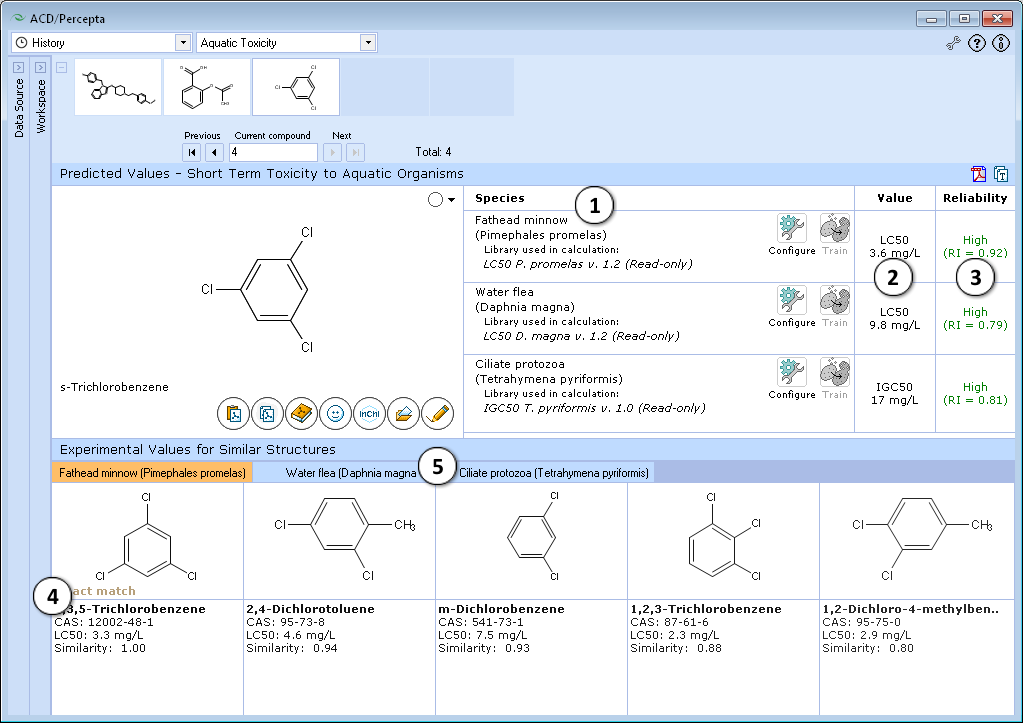Aquatic Toxicity LC50: Difference between revisions
| Line 18: | Line 18: | ||
[[Image:Aquatic_toxicity_lc50.png|center]] | [[Image:Aquatic_toxicity_lc50.png|center]] | ||
<br /> | <br /> | ||
# Calculations are presented in the form of a table. Each row contains dedicated "Configure" and "Train" buttons to select the training library for the particular species and to add new data to that library. Predictions are made for the two aquatic species most frequently used for testing - Fathead minnows (''Pimephales promelas'') and Water fleas (''Daphnia magna'') | # Calculations are presented in the form of a table. Each row contains dedicated "Configure" and "Train" buttons to select the training library for the particular species and to add new data to that library. Predictions are made for the two aquatic species most frequently used for testing - Fathead minnows (''Pimephales promelas'') and Water fleas (''Daphnia magna'') | ||
| Line 29: | Line 28: | ||
# Up to five most similar compounds from the training set with names, CAS numbers and experimental LC50 values. | # Up to five most similar compounds from the training set with names, CAS numbers and experimental LC50 values. | ||
# Click the tab to browse the similar structures for different species. | # Click the tab to browse the similar structures for different species. | ||
<br /> | |||
<div class="mw-collapsible mw-collapsed"> | <div class="mw-collapsible mw-collapsed"> | ||
Revision as of 13:08, 29 May 2012
Overview
Aquatic toxicity module provides the researcher with an accurate and reliable predictive tool that may serve as a valuable first estimate of fish and daphnid toxicity of new chemical entities that is required under REACH. It may therefore be used as an initial screen that could compete and become at least a partial replacement of time and resource consuming experimental determination in animals.
Features
- A standard measure of aquatic toxicity is the concentration of the compound in water that is lethal to 50% of exposed organisms (LC50).
- Provides the predictive models of LC50 (mg/L) for two species that are typically used in aquatic toxicity assays: Fathead minnow (Pimephales promelas) and Water flea (Daphnia magna).
- The calculated LC50 values are supported by reliability indices (RI) that provide an estimate of the prediction accuracy.
- RI values represent a quantitative evaluation of prediction confidence. High RI shows that the calculated value is likely to be accurate, while low RI indicates that no similar compounds with consistent data are present in the training set.
- The training sets used to build the models contain experimental data on aquatic toxicity for about 900 compounds in case of fathead minnows and about 600 compounds in case of water fleas.
Interface

- Calculations are presented in the form of a table. Each row contains dedicated "Configure" and "Train" buttons to select the training library for the particular species and to add new data to that library. Predictions are made for the two aquatic species most frequently used for testing - Fathead minnows (Pimephales promelas) and Water fleas (Daphnia magna)
- The predicted value is LC50 of the analyzed compound for a given organism, expressed in mg/L.
- Predictions are supported by Reliability Index values ranging from 0 to 1 that serve as an intrinsic evaluation of prediction confidence:
- RI < 0.3 – Not Reliable,
- RI in range 0.3-0.5 – Bordeline Reliability,
- RI in range 0.5-0.75 – Moderate Reliability,
- RI >= 0.75 – High Reliability
- Up to five most similar compounds from the training set with names, CAS numbers and experimental LC50 values.
- Click the tab to browse the similar structures for different species.
Technical information
Calculated quantitative parameters
Standard measure of aquatic toxicity is the concentration of the compound in water that is lethal to 50% of exposed organisms (LC50). To obtain a linear relationship with structural properties these data were converted to logarithmic form (pLC50) for modeling, but the final prediction result is returned as an original LC50 value in mg/L.
Experimental data
Experimental data that was used for the development of predictive models was collected from EPA reference databases, as well as original publications. After thorough verification of the obtained values the final data sets contained about 900 compounds with quantitative LC50 values characterizing acute toxicity to fishes (Pimephales promelas), and about 600 compounds - to water fleas (Daphnia magna).
Model features & prediction accuracy
The models for calculating LC50 of chemicals for aquatic organisms were developed according to the same methodology as Trainable models. As a result, these models share the same advantage - possibility to obtain an intrinsic evaluation of prediction confidence by the means of Reliability Index (RI) values supporting each prediction. RI ranges from 0 to 1 and serves as an indication whether a submitted compound falls within the Model Applicability Domain:
- RI < 0.3 – Not Reliable - compound lies outside of the Model Applicability Domain
- RI between 0.3 and 0.5 – Borderline Reliability
- RI between 0.5 and 0.75 – Moderate Reliability
- RI >= 0.75 – High Reliability
The resulting models are highly accurate: LC50 values for aquatic species are predicted with RMSE 0.5-0.6 log units when only predictions of moderate and high reliability (RI >= 0.5) are considered (RI values in the high and moderate ranges are provided for 30-60% of the validation sets).